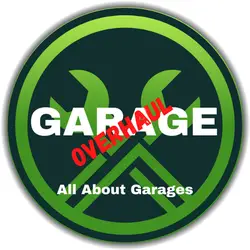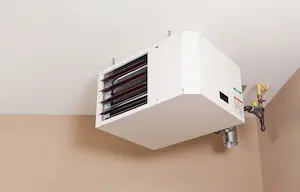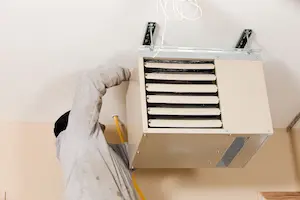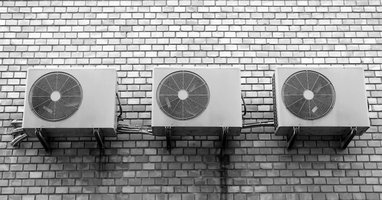How to Cool a Garage (Options and Advice)
This post contains affiliate links.
When summer months come, the blazing summer heat can turn your garage into an oven, baking you inside. In that situation, you may ask yourself: How do I cool down my garage?
You can cool down your garage by:
- Installing HVAC system
- Installing an evaporative/swamp cooler
- Putting in a portable air conditioner
- Install windows or wall AC unit system.
- Use dehumidifiers
- Ventilating your garage
In this article, we look at how you can cool down your garage. We also look at some of the pros and cons of these options. Finally, we try to answer some of the common questions about garage cooling you may have.
QUICK TIP: After reading this article, check out our Buyer’s Guide: The Best Air Conditioners & Coolers for a Garage. You’ll get more information on how to shop for the best AC for your garage.
Why Is My Garage Too Warm?
Your garage may get too warm due to reasons such as the following:
- Under or no insulation
- Lack of ventilation
- Garage Orientation
- Garage wall color
- High humidity
- Your car
- Too many things inside the garage
During the hot summer months, working inside a garage can be torture. There are many reasons why your garage can turn into an oven and become too warm.
Under Or No Insulation
People may think Insulation helps keep your garage warm during winter. However, it does not just keep your garage warm; it can also keep your garage cool.
Insulation prevents the summer sun from heating up the air inside your garage. This means the air inside your garage stays cool and keeps you cool too.
No Ventilation or Windows
The more natural way to cool down your garage is to ventilate the air inside. The idea is to allow hot air inside to move up and out, so cooler air can come in. This can be done with windows, ventilation holes, and more.
However, not all garages have these built in. If the hot air cannot escape, it pools inside the garage, raising the temperature.
Garage/House Orientation and Location
Suppose your house and garage face to the south or west. In this case, they will heat up during the afternoon sun. How hot your garage may get may depend on how the sun orientates to your location.
For most situations, use it early if you do not have a way to cool your garage. Your garage should stay cool from early morning until around 10–11 AM. Your garage gets really hot from 3–6 PM.
Garage Colors
Your Garage door and roof colors can also heat up your garage. The idea is that the darker the colors, the more heat they absorb. This heat eventually travels into the air inside your garage, raising the temperature.
It may be better to paint the exterior of your garage with lighter colors to prevent this from happening.
High Humidity
Humidity can make an already warm garage unbearable. This is because high humidity traps heat and makes the air feel hotter than it actually is. This is why tropical areas feel much hotter.
Lowering the humidity will help make it more comfortable. Consider using a dehumidifier to help achieve this.
Your Car
People may forget that they could be introducing a heat source into their garage. For example, suppose you park your car with a hot engine in the garage. The heat will radiate from a vehicle for a long time, warming up the air inside your garage.
As a result, your garage will heat up very fast. Please park your car outside in the shade or wait for sunset before driving to the garage.
Too Much Stuff in the Garage
Suppose you have loads of objects, clutter, and stacked boxes in your garage. In this case, they will obstruct the proper airflow. Clutter in the garage also limits your ability to use your garage’s full capabilities.
If you are serious about cooling down your garage, clean up and de-clutter the space. You can add helpful storage systems and cabinets, and overhead storage. You can also have wall systems such as French cleats or slat walls.
These systems will keep your garage nice and tidy. The air flowing inside your garage will also be much more straightforward and cooling.
How To Cool Down A Garage?
There are many options to cool down a garage. We list some of the most common options below for you to check out:
HVAC (Heating, Ventilation, and Air Conditioning)
An HVAC is just like your home’s central air condition system. You can actually install a separate HVAC system for your garage. But this can be a costly option since, in most cases, you need an HVAC professional to do it.
Some may try to extend their home HVAC to their garage. However, you should not use your home system to cool the attached garage. This is because it’s not designed to do so.
The large air volume in the garage that needs to be cooled will put a massive strain on your central air system. The garage also has pollutants like carbon monoxide from your car. You don’t want these gases lingering in your home.
Mini Split Air Conditioner
Mini-split systems have 2 parts. A small, wall-mounted air condition unit pumps out cool air into your garage. There is an outside compressor unit too. This is akin to the central AC unit on your house but on a smaller scale.
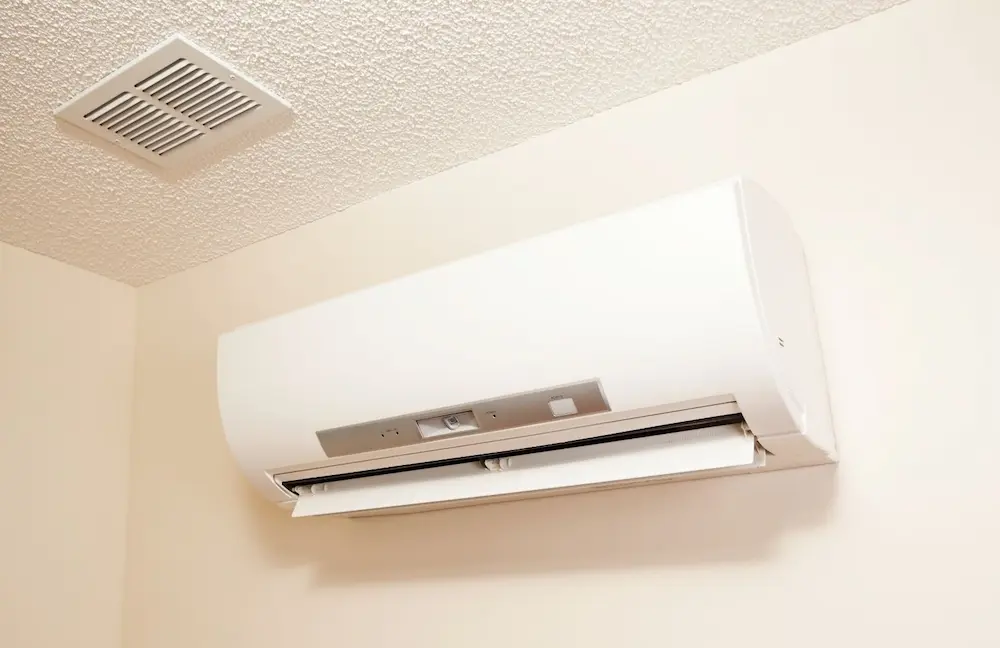
Only power and refrigerant lines run through the wall, making the installation fast. They are also easy to place side by side. Many models also do more than just cooling. Some can heat, dehumidify or ventilate like a fan.
Mini-splits are more expensive than Windows AC units. They also need to be installed by HVAC professionals usually. Some models offer DIY installation.
Windows/Wall AC units
Window AC and wall AC units are cheap and effective. Standard windows AC unit can be a good choice for a garage, especially if your garage has large windows. Windows AC unit is also a plug-and-play solution. This means you don’t need professional installation.
Wall AC units are usually better and safer for garages. However, they do cost more. Wall AC units can be considered if your garage windows are not big enough for window AC units.
Dehumidifiers
High humidity traps heat and makes the air feel hotter than it actually is. If you live in a region with high humidity. Lowering the humidity of the air will help make it more comfortable.
A dehumidifier works by drawing warm air into itself using a fan. This air then enters its cooling coil. The warm air then contracts the cooling coil with refrigerator liquid on the other side. This makes the warm air contract, learning condensation inside the dehumidifier.
The air then passes out with less humidity and dryer. It may also be a little cooler, although not by much.
You can instantly feel 5-10 °C (41 – 50°F) degrees cooler with a dehumidifier. This is because the relative humidity is reduced. However, you will still need a cooling system working alongside your dehumidifier. This is because it does not blow out cold air.
Fans
Consider a ceiling fan if you have the space and if your garage door opener is not in the way. You can use portable versions too. You can also install exhaust fans in a window or through the wall.
Get an industrial-strength fan with stronger blades instead of a residential version. This is especially if you do woodworking or other work in your garage. This work may create sawdust or other debris in the air.
In many cases, industrial fans are better suited to garages anyway.
Fans also benefit from sucking any fumes out of your garage. This keeps the air inside your garage safe.
Portable Air Conditioners
Depending on the unit’s efficiency, portable air coolers can cool a small to medium space. If the garage has a large air volume, a portable unit may not be enough during hotter days. This is because it is usually not as strong.
Portable units also take up floor space and must be vented to the outside air. Most portable air conditioning systems have a hose and adapter to vent outdoors. This means you need a hole in the wall if you don’t have windows in your garage.
If you know how to operate a reciprocating saw, then creating a ventilating hole should be easy. You can also hire an expert to install an exhaust vent, although it will cost you more.
What Size Of Air Conditioner Do I Need For My Garage?
The right AC size for your garage can be calculated using the square footage of your garage. Multiply it by 25 to get the BTU rating needed for your AC. Factors such as sunshine and humidity may influence your desired final AC size.
Air conditioners are usually rated in British Thermal Units (BTU). a BTU is equal to the heat required to raise the temperature of a pound of water by one degree Fahrenheit. The same calculation can also be used to cool water.
BTU readings can be in the tens of thousands, which means, at times, you may see BTU figures in ‘Tons.’ For example, if you see an AC unit with a 25 Tons BTU rating, add three zeros. This means the AC has a cooling power of 25,000 BTUs.
To determine the right AC size for your garage:
- Measure the size of your garage, then multiply the length by the width.
- Multiply the figure by 25 to get the BTUs you need.
For example, suppose your garage is 20 x 20 feet. Multiply that, and you get 400. Further, multiply 400 by 25, and you should arrive at 10,000 BTU. This means you need an AC with a BTU rating of 10,000 or more.
You can use a BTU calculator to help you perform this calculation too.
However, there may be extra factors you want to consider when determining your AC size. These factors may need you to increase your AC’s BTU rating.
- If your garage gets a lot of suns, increase capacity by 10%
- If your garage is heavily shaded, reduce capacity by 10%
- Add 2,000 to 4,0000 BTUs if the garage is uninsulated.
- Add 1,000 to 2,000 BTUs if your garage faces south and/or west.
- Add 1,000 BTUs if your climate is very sunny rather than cloudy.
- Add 1,000 to 2,000 BTUs if your garage is in a very humid climate like the South, Southeast, or Northeast.
A properly sized AC rewards you with energy savings. Consult an AC expert if you are unsure how to size your air conditioner.
How Much Does Cooling Down A Garage Cost?
A garage cooling system can cost between $150 to $8,900. The actual cost may depend on the solutions installed. You can also ventilate your garage by opening the windows and doors to cool it down.
| Cooling Solutions | Cost |
| Central System | $3,500 – $8,900 |
| Ductless Split Systems | $1,000 – $5,000 |
| Window Air Conditioners | $150 to $700 |
| Portable Units | $150 – $700 |
Installing a garage cooling system can cost differently, depending on the type. There are affordable ones and also expensive solutions to choose from.
Suppose you go for a full-fledged, central system like an HVAC. In this case, prepare to pay between $3,500 and $8,900. You will get a full-on duct system that you can also combine with the heating system.
If you install a ductless split system, this should cost you around $1,000-$5,000 installed. These mini-split and ductless units are installed as inside and outside units.
If you settle on window air conditioners, these should be affordable. It should cost $150-$700 to install. The price range should be about the same for portable AC units too.
However, use this cost estimation as a ballpark figure. This is because the actual cost may vary. The factors may include location, workmanship, and building code requirements.
Can I Cool Down My Garage Cheaply?
You can cool down your garage cheaply by ventilating it. Open the doors and windows, and then use a fan to move hot air from your garage. This should encourage air circulation, helping your garage feel cooler.
Not all of us have the budget to install cooling systems. We may not see the need to do that if the house is rented.
To cool down your garage’s air cheaply, you can start by ventilating it. Improving garage ventilation will help draw cooler air in and push the hot air out.
The most cost-effective and easiest way to ventilate your garage is to open up doors and windows. Opening the garage or entry door allows air to come in and out. You also create a cross-breeze. The airflow will keep the garage a little bit cooler.
You can also install vents to the attic, walls, or garage doors. This can help most of the heat escape through your garage attic. Vents create airflow to cool the garage with passive convection. In passive conversion, cool air moves from the ground upwards, forcing the hot air out.
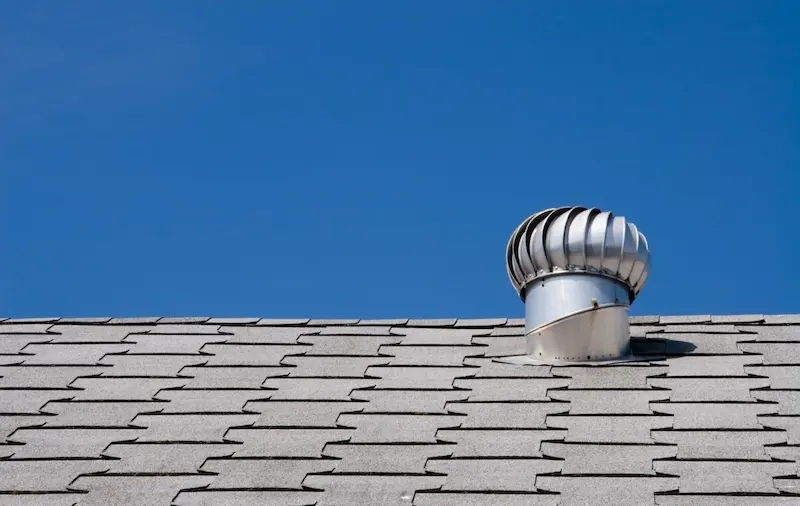
You can also have fans. You can install roof turbine vents to suck out hot air. You can also install fans in the ceiling or walls.
Finally, if you want cheap cold air. Build a “DIY Swamp cooler” with a bucket of ice with a fan blowing across it. Or cut 2 holes in the bucket side and put the fan blowing towards the ice from above.
FAQ
How Hot Do Garages Get In Summer?
Garages can get very hot inside, especially during summer. The inside temperature of your garage can be 10-18° F or 5-10 °C higher than outside during a hot day.
The temperature may be higher if your garage is not insulated or has poor ventilation. The temperature difference may be even higher if you live in a location with high humidity.
Should I Air Condition My Garage?
The decision to cool your garage or not may depend on usage. If your usage is low and you don’t spend much time in your garage. Then maybe fans, portable AC, or a swamp cooler could be a good option.
On the other hand, if you spend a lot of time in your garage doing work, projects, gym, or game room. You’ll want to maybe invest in a more permanent way to keep the hot air in the bay. Consider mini-split AC systems. You can also bring in windows or wall AC.
Also, if you store valuables sensitive to temperature changes and humidity. You should consider a garage air conditioning system. If you have a room above or surrounding the garage. Cooling your garage helps keep the adjacent rooms cooler.
How To Cool A Garage With No Windows?
If your garage doesn’t have windows or proper ventilation, it may be hard to cool it down. But you can still prevent heating up inside the garage. There are also affordable solutions to cool down a windowless garage.
Start by not introducing hot air. Please park your car outside to cool down or wait for sunset before driving to the garage. You can also replace your garage lights with LEDs. Regular lights produce heat and can warm up your garage.
You can also open the garage door and use fans to encourage ventilation. Portable AC units can also help, although they may cost a little more.
If you have an extra budget, you can also install garage windows. You can also add vents to the attic and roof to help ventilate your garage better.
How To Use A Fan To Cool Down My Garage?
Fans are a good option to cool down your garage if used wisely. The goal is to move the air so hot air leaves your garage. At the same time, it should help bring in cold air.
To put that into practice, observe the air temperature. If the outside air is hotter, blow the air out of the garage.
During the evening, reverse the airflow. This helps to draw cooler air outside to inside your garage.
Suppose your garage is attached and has a smaller service door. In this case, you can keep the door open and draw the cooler air into your garage.
Can Cooling And Ventilating My Garage Clean My Garage Air?
Cooling and ventilating your garage air helps to prevent the air from becoming toxic.
If you think about it, you keep a lot of chemicals, oil, paint, pesticides, harsh cleaning supplies, and other similar things you might store in your garage. There are also pollutants like your car exhaust emitting dangerous carbon monoxide.
On top of that, if you use your garage as a workshop, you may produce large amounts of wood dust, metal shavings, metal dust, and paint particles.
Ventilation helps to dissipate these fumes and particles. This should prevent the air from becoming toxic and unhealthy, keeping you, your family, and your pets safe.
Make it a point to ventilate your garage frequently by opening the garage doors and windows. If you have a cooling or ventilation system, turn them on while you work.
